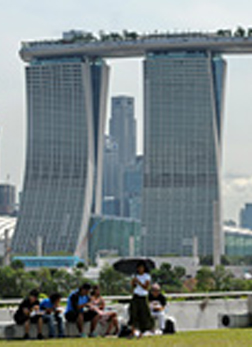Articles
Hoteliers Reap Windfall
As Singapore Reinvents Itself
News - Articles

Even as Singapore's trade-dependent economy faces risks in the wake of a global slowdown,
one sector in this Southeast Asian island state stays upbeat.
In this year's Forbes rich list for Singapore released in July, 10 of the 40 wealthiest individuals were
either hoteliers or property tycoons with a growing stake in the hospitality business - an indicator
of the robustness of the industry.
The owner of budget chain, Hotel 81, Choo Chong Ngen made his debut on the list at No. 25 with a net worth of $690 million.
Snapping at his heels at spot 26 was another newcomer Michael Kum with a net worth of $670 million.
His M&L Hospitality Trust has many hotels in its portfolio.
The largest listing in the city state's otherwise lackluster market for new issuances was also from the hospitality sector, with Ascendas
Hospitality Trust raising $600 million in July.
The hotel industry has had a great year so far with total room revenues over the first half hitting $1.1 billion, according
to the Singapore Tourism Board, a jump of 6.6 percent year on year.
The sector is reaping the benefits of a growing number of visitors, who continue to flock the tiny island for leisure
and business. A financial hub and gateway to the Far East, Singapore has continuously been reinventing itself to
attract visitors. From 2008 it has been hosting the Formula One's only night race and in 2010 opened its first casino. It is also
increasingly positioning itself as a medical tourism and educational hub.
"Singapore's unique proposition is that it has a good mix of demand drivers like medical, convention and education tourism that insulate it from
the vagaries of leisure tourism. There is no one reason that draws visitors here," says Robert McIntosh, Executive Director of CBRE Hotels,
advisors to the hospitality industry.
Nearly 6 million people visited Singapore over January to May 2012, an increase of 12.3 percent year on year, boosting daily room
rents and occupancy rates at its hotels, according to the Singapore Tourism Board.
In the first quarter of the year average daily room (ADR) rates rose more than 11 percent year on year to $206 and revenue per available
room (RevPar) grew 14.7 percent to $178, according to CBRE Hotels.
The occupancy rate in the first quarter was 87 percent, the same as last year, but industry experts expect full year
occupancy rates to beat that.
"The historic high RevPar is an indication that the hospitality industry is performing very well. This reverses our earlier
assessment that global events may cast a shadow on hotel performance in Singapore," says McIntosh.
Singapore's average room rents have beaten those of other big Asian cities. In June, for example, Singapore hotels were
commanding an average daily room rent of $230, while in Seoul the rents were $185.
In the first six months daily room tariffs have fallen 0.1 percent in neighboring Kuala Lumpur, while in Shanghai they are down
3.2 percent, according to CBRE Hotels.
Year-End Boost
As the global economic uncertainty worsens, there are doubts whether the sector will continue to deliver on good growth.
The Ministry of Trade and Industry had said in August that tourism had begun to slow, according to a Reuters report.
But Derek Tan, Hotel Industry Analyst at DBS Vicker Research, says the second half of the year could be even better for Singapore's hotel
industry as it is traditionally the peak period.
"With a pick-up in conference activity and events, we believe the overall industry has room to catch up with industry leaders like
Marina Bay Sands and Resort World Sentosa commanding occupancy above 90 percent despite the average ADR touching a high of $320 a night," Tan said.
Marina Bay Sands, subsidiary of Las Vegas Sands, Singapore's iconic landmark of three hotel towers topped by a floating sky
park that opened in 2010 has grown into its hottest tourist destination with its Las Vegas-style casino, while Resorts World
Sentosa's key attraction include the Universal Studios theme park besides a casino.
Singapore is targeting 13.5 million to 14.5 million visitor arrivals in 2012, more than the 13.2 million people who
visited Singapore last year, according to the Singapore Tourism Board.
The city plans to achieve this by continuously adding to its list of attractions. In May 2012, Asia's largest $400 million
Marina Bay Cruise Center was completed raising Singapore's potential as a cruise gateway to Southeast Asia. In June 2012 the Gardens
By the Bay, a horticulture sanctuary of forest clouds and flower domes on 250 acres of reclaimed land was also launched.
As Singapore prepares to welcome even more tourists, the number of hotel rooms are expected to increase 26 percent by 2016 according
to data from CBRE Hotels. But industry experts see no danger of a glut in the market.
“The market has experienced tight room inventory recently. The additional supply would alleviate the room crunch experienced by Singapore,”
says David Ling, Chairman, China and Southeast Asia at hotel consultancy HVS.
Asok Hiranandani, proprietor of the real estate and hotel firm Royal Group Holdings, who also made it to the Forbes rich list this
year, says, "For another five years, at least, I see the hotel boom continuing. Asia is poised to be the engine of growth and
this will keep hotels in robust health."
Source: www.cnbc.com





